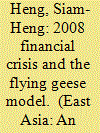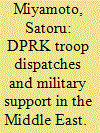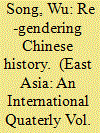| Srl | Item |
| 1 |
ID:
100726


|
|
|
|
|
| Publication |
2010.
|
| Summary/Abstract |
In the twentieth century Japan embarked on an economic developmental path that came to be known as the Flying Geese Model. The geopolitical milieu after the Second World War provided Japan with favourable conditions for rapid economic growth and industrialization. By the 1950s, many had noticed the success of the model and it was subsequently adopted by other East Asian countries. They too enjoyed decades of remarkable economic growth. An important element of the model is growth driven by export to the USA and Europe. As a result of the 2008 financial crisis, the traditional markets of the geese are shrinking. The new situation poses grave challenges to both the existing flying geese economies and latecomer economies which wish to follow the model. East Asian countries are responding to the situation by broadening and deepening their existing economic linkages and developing new ones. This represents a continuation of East Asian regionalism in the wake of the 1997 financial crisis.
|
|
|
|
|
|
|
|
|
|
|
|
|
|
|
|
| 2 |
ID:
100723


|
|
|
|
|
| Publication |
2010.
|
| Summary/Abstract |
Does the rise of China present a threat or an opportunity for Southeast Asia? One of the most revealing arenas in which this will be determined will be within the context of regional institution-building. For a region that is perennially associated with under-institutionalisation it is remarkable just how many initiatives have been proposed recently. Such institutions, may be important venues within which 'asymmetric regionalism' may be manifest and perhaps managed. The paper provides an assessment of this process through an analysis of China's relationship with Southeast Asia. The paper initially provides a brief theoretical introduction which explains the relationship between regional development and its possible impact on inter-state relations. Following this I provide an analysis of the political economic and strategic dynamics that are shaping and being shaped by regional initiatives. Finally, I assess how successful ASEAN's efforts have been to engage China via regional mechanisms has actually been.
|
|
|
|
|
|
|
|
|
|
|
|
|
|
|
|
| 3 |
ID:
100724


|
|
|
|
|
| Publication |
2010.
|
| Summary/Abstract |
The DPRK now trades in arms with the Middle East. However, in the October War (1973) the DPRK first began military cooperation with the Middle East by sending troops and providing unrequited military support. This switch was made to win support within the UN from these Middle Eastern countries, and so to counteract the US presence in the UN. Failing this, the DPRK withdrew from the UN in 1976. The DPRK then turned to arms trading both to build up its foreign currency reserves and to help liberate developing countries from US control.
|
|
|
|
|
|
|
|
|
|
|
|
|
|
|
|
| 4 |
ID:
100725


|
|
|
|
|
| Publication |
2010.
|
| Summary/Abstract |
Historians who share the written Chinese language as a carrier of cultural signification have negotiated the image of female emperor Wu Zetian with the signs of the times designated by the needs of the present. The female writer Zhao Mei's new biography Woman: Wu Zetian deconstructs the historical and cultural representation of Wu Zetian as the 'bad unwoman'; links a woman's private, and subjective experiences with her public and political activities; and demonstrates that how the former influences the latter. This paper examines how the participation of contemporary biographers in knowledge production constructs, legitimises and maintains the image of Wu Zetian as a woman and a ruler. It argues that Zhao Mei's biography of Wu Zetian manages to confront the established dominance of male hierarchy, questions the 'stigmatised identity' of this historical character as being stable and universal and, consequently re-genders an important chapter in Chinese history.
|
|
|
|
|
|
|
|
|
|
|
|
|
|
|
|